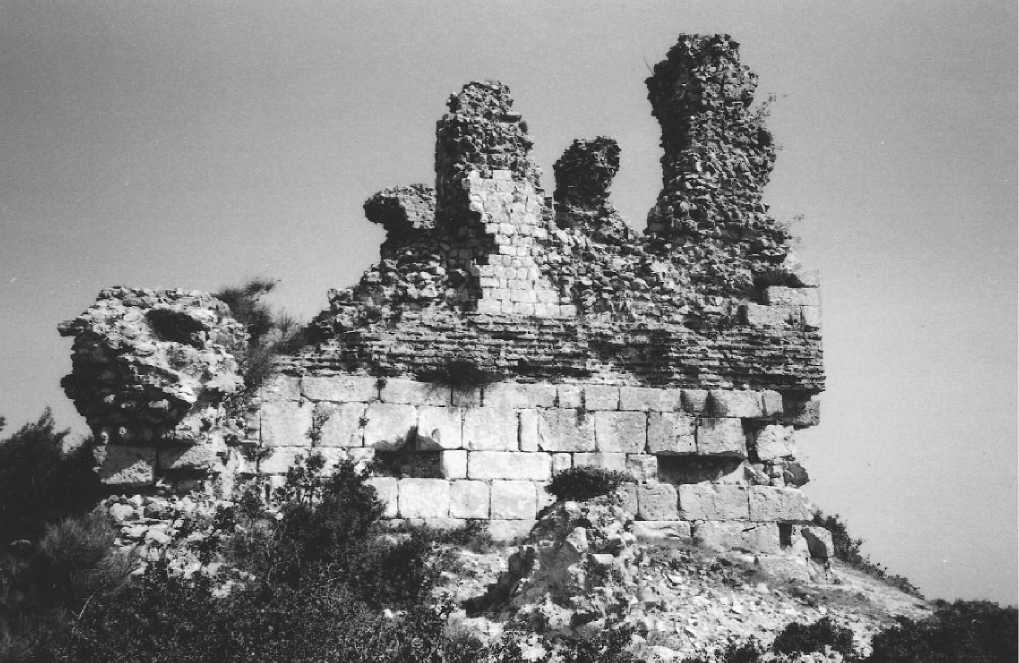Antioch (mod. Antakya, Turkey) was a city situated on the river Orontes (Asi Nehri) in Syria. It was captured from the Saljuq Turks in 1098 by the armies of the First Crusade (1096-1099) and thereafter became the capital of the Frankish principality of Antioch until it was taken by the Mamluks of Egypt in 1268.
One of the greatest cities of the ancient world, Antioch was famous for the antiquity of its Christian community and its rank as one of the four patriarchates of the Christian Church. It was in this city that Christians were first called by that name, and its theological school had a profound impact on the development of Christianity. A series of disasters struck the city in the sixth and seventh centuries; the Persians pillaged the city in 540, removing much of the population to Mesopotamia, and again held the city from 611 to 628. After briefly recapturing the city under Emperor Heraclius, the Byzantines lost the city again to the Arabs in 638. The his-

Ruins of the walls of Antioch. (Courtesy Alfred Andrea)
Tory of Antioch under Arab rule is obscure, but the city was recovered by the Byzantines in 969. The collapse of Byzantine authority in Syria and Anatolia in the mid-eleventh century left Antioch under the rule of the Armenian warlord Phi-laretos, but in 1084 the city fell to the Saljuqs.
Antioch’s strategic location ensured that it would be one of the principal targets of the First Crusade. The city fell on 3 June 1098 when Bohemund of Taranto induced a disaffected member of the Turkish forces to admit the crusaders into the city through a postern gate. Bohemund’s fellow crusaders acceded to his claim to the city, thus breaking their policy of restoring former Byzantine territories to the empire. This decision set in motion a half-century of conflict between Antioch and Byzantium. Within weeks of capturing the city, the crusaders were themselves besieged by a large Turkish army led by Karbugha of Mosul. The crusaders won a decisive victory on 28 June, and Antioch was theirs. The city became the capital of a Frankish principality established by Bohemund and his descendants.
The city was located on the east bank of the Orontes and surrounded by high mountains to the east and west. River silt now covers much of the ancient and medieval city, and the few excavations in the city have focused on its ancient and late antique periods. Latin, Greek, and Arabic sources testify to the impressive walls that surrounded the city, relics of Emperor Justinian’s rebuilding of the city after the Persian invasion of 540. The walls themselves are more than 12 kilometers (71/2 mi.) long. A citadel, dating to the early Byzantine era, was located on the eastern walls high on Mount Silipios. The city had six main gates. The northern gate, named after the monastery of St. Paul, led to Aleppo. The southern gate of St. George, named after an adjacent Jacobite church, led south to Laodikeia (mod. al-Ladhiqiyah, Syria). On the western side were the Dog Gate, the Duke’s Gate, and the Bridge Gate, and on the mountainous eastern side was the Iron Gate.
On the eve of the crusader siege, the city was predominantly populated by Christians of the Greek Orthodox,
Armenian Orthodox, and Syrian Orthodox faiths, and the conquest of the city likely drove out or massacred much of the Muslim population. It is likely that most of the inhabitants spoke Greek. A Greek Orthodox patriarch remained the leader of both the Latin and Greek communities until 1100, when Bohemund I expelled the venerable John of Oxeia on suspicion of collaborating with his Byzantine enemies, replacing him with the Latin Bernard of Valence.
The cathedral of St. Peter was probably the church built by Justinian. Its sanctuary collapsed in the earthquake of 1170, killing the Orthodox patriarch Athanasios I Manasses. St. Peter’s served as the tomb for the princes and patriarchs of the city; it was also the burial place of Adhemar of Le Puy, the papal legate on the First Crusade, and Frederick I Bar-barossa, leader of one of the armies of the Third Crusade (1189-1192). Also located within the city were the churches of St. Andrew, founded by Raymond of Saint-Gilles, and St. Leonard, founded by Bohemund I in thanksgiving for his release from Turkish captivity. A Frankish nobleman built a church dedicated to the Syrian Orthodox (Jacobite) saint Barsauma after his child was healed by the saint’s relics; both Latins and Syrian Orthodox Christians attended its consecration. Surrounding the city were a number of important sites. The important Syrian Orthodox monastery of Dovair was established outside the city near the ancient suburb of Daphne.
The princes of Antioch ruled the city through a dux (duke) second only to the prince in authority over the city, who presided over a city council. The offices of duke and judge may well derive from Byzantine precedents.
Antioch faced various threats to its survival as a Frankish possession. During the early twelfth century, the Byzantines made concerted efforts to reintegrate the city into the empire. However, Emperor Manuel I Komnenos embarked on a policy of cooperation, joining the Franks in opposing the attacks of Nur al-Din. Antioch was one of the only major cities of Outremer not captured by Saladin in 1187. The city itself prospered economically under the Norman dynasty. It continued to have a substantial Greek population, which expressed its political voice through a commune formed in the late twelfth century. The commune was particularly opposed to Armenian domination of Antioch, a threat that hung over the city during the War of the Antiochene Succession in the early thirteenth century. The city was captured by Baybars I, Mamluk sultan of Egypt, on 18 May 1268. The city’s population was massacred, and Antioch never reclaimed the importance it had known in ancient and medieval times.
-Christopher MacEvitt
Bibliography
Asbridge, Thomas, The Creation of the Principality of Antioch, 1098-1130 (Woodbridge, UK: Boydell, 2000).
Cahen, Claude, La Syrie du Nord a I’epoque des croisades et la principaute franque d’Antioche (Paris: Geuthner, 1940). Hamilton, Bernard, “Three Patriarchs at Antioch,
1165-1170,” in Gesta Dei per Francos, ed. Benjamin Z. Kedar, Michel Balard, and Jonathan Riley-Smith (Aldershot, UK: Ashgate, 2001), pp. 199-207.




 World History
World History









